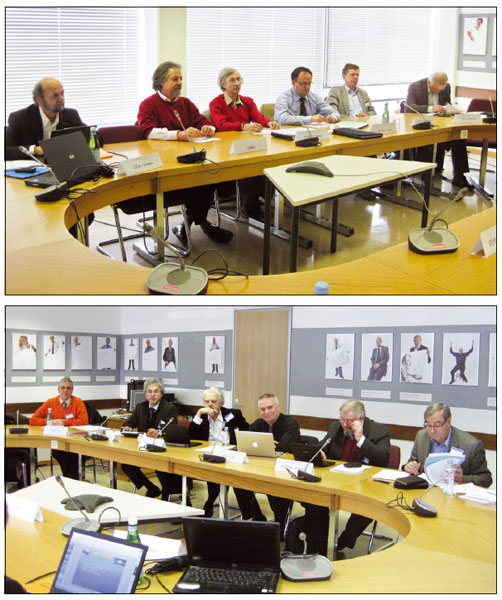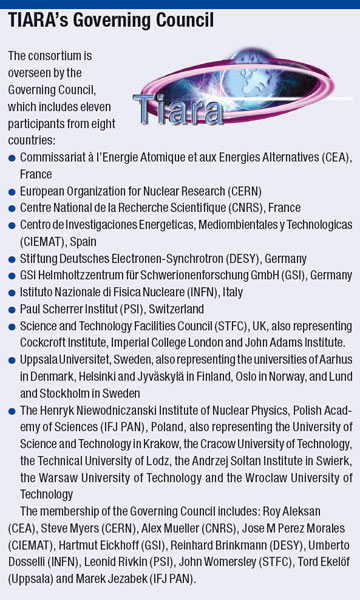The new EC-supported preparatory project has held its first meeting.

Image credit: TIARA management team.
Particle accelerators are vital state-of-the-art instruments for both fundamental and applied research in areas such as particle physics, nuclear physics and the generation of intense synchrotron radiation and neutron beams. They are also used for many other purposes, in particular medical and industrial applications. Together, the “market” for accelerators is large and steadily increasing year on year. Moreover, R&D in accelerator science and technology, as well as its applications, often leads to innovations with strong socio-economical impacts.
New accelerator-based projects generally require the development of advanced concepts and innovative components with continuously improving performance. This necessitates three levels of R&D: exploratory (validity of principles, conceptual feasibility); targeted (technical demonstration); and industrialization (transfer to industry and optimization). Because these developments require increasingly sophisticated and more expensive prototypes and test facilities, many of those involved in the field felt the need to establish a new initiative aimed at providing a more structured framework for accelerator R&D in Europe with the support of the European Commission (EC). This has led to the Test Infrastructure and Accelerator Research Area (TIARA) project. Co-funded by the European Union Seventh Framework Programme (FP7), the three-year preparatory-phase project started on 1 January 2011, with its first meeting being held at CERN on 23–24 February.
The overall aim of TIARA is to facilitate and optimize European R&D efforts in accelerator science and technology in a sustainable way
The approval of the TIARA project and its structure continues a strategic direction that began a decade ago with the report in 2001 to the European Committee for Future Accelerators from the Working Group on the future of accelerator-based particle physics in Europe, followed by the creation of the European Steering Group on Accelerator R&D (ESGARD) in 2002. This was reinforced within the European Strategy for particle physics in 2006. The main objective is to optimize and enhance the outcome of the accelerator research and technical developments in Europe. This strategy has been developed and implemented with the incentive of the Framework Programmes FP6 and FP7, thanks to projects such as CARE, EUROTeV, EURISOL, EuroLEAP, SLHC-PP, ILC-HiGrade, EUROnu and EuCARD. Together, these programmes represent a total investment of around €190 million for the period covered by FP6 and FP7 (2004 to 2012), with about €60 million coming from the EC.
The overall aim of TIARA is to facilitate and optimize European R&D efforts in accelerator science and technology in a sustainable way. This endeavour involves a large number of partners across Europe, including universities as well as national and international organizations managing large research centres. Specifically, the main objective is to create a single distributed European accelerator R&D facility by integrating national and international accelerator R&D infrastructures. This will include the implementation of organizational structures to enable the integration of existing individual infrastructures, their efficient operation and upgrades, as well as the construction of new ones whenever needed.
Project organization
The means and structures required to bring about the objectives of TIARA will be developed through the TIARA Preparatory Phase project, at a total cost of €9.1 million, with an EC contribution of €3.9 million. The duration is 3 years – from January 2011 to December 2013 – and it will involve an estimated total of 677 person-months. The project is co-ordinated by the French Alternative Energies and Atomic Energy Commission (CEA), with Roy Aleksan as project co-ordinator, François Kircher as deputy co-ordinator, and Céline Tanguy as project-assistant co-ordinator. Its management bodies are the Governing Council and the Steering Committee. The Governing Council represents the project partners and has elected Leonid Rivkin, of the Paul Scherrer Institute, as its chair. The Steering Committee will ensure the execution of the overall project’s activities, with all work-package co-ordinators as members.
The project is divided into nine work packages (WP). The first five of these are dedicated to organizational issues, while the other four deal with technical aspects.
WP1 focuses on the consortium’s management. Its main task is to ensure the correct achievement of the project goals and it also includes communications, dissemination and outreach. The project office, composed of the co-ordinator and the management team, forms the core of this work package, which is led by Aleksan, the project co-ordinator.
The main objective of WP2, also led by Aleksan, is to develop the future governance structure of TIARA. This includes the definition of the consortium’s organization, the constitution of the statutes and the required means and methods for its management, as well as the related administrative, legal and financial aspects.
WP3 is devoted to the integration and optimization of the European R&D infrastructures. Based on a survey of those that already exist, its objective is to determine present and future needs and to propose ways for developing, sharing and accessing these infrastructures among different users. This work package will also investigate how to strengthen the collaboration with industry and define a technology roadmap for the development of future accelerator components in industry. It is led by Anders Unnervik of CERN.
The main objective of WP4 is to develop a common methodology and procedure for initiating, costing and implementing collaborative R&D projects in a sustainable way. Using these procedures, WP4 will aim to propose a coherent and comprehensive joint R&D programme in accelerator science and technology, which will be carried out by a broad community using the distributed TIARA infrastructures.
The development of structures and mechanisms that allow efficient education and training of human resources and encourage their exchange among the partner facilities is the goal of WP5. The main tasks are to survey the human and training resources and the market for accelerator scientists, as well as to establish a plan of action for promoting accelerator science. This work package is led by Phil Burrows of the John Adams Institute in the UK.
WP6 – SLS Vertical Emittance Tuning (SVET) – is the first of the technical work packages. Its purpose is to convert the Swiss Light Source (SLS) into an R&D infrastructure for reaching and measuring ultrasmall emittances, as will be required for damping rings at a future electron–positron linear collider. This will be done mainly by improving the monitors that are used to measure beam characteristics (position, profile, emittance), and by minimizing the magnetic field errors, misalignments and betatron coupling. This work package is led by Yannis Papaphilippou of CERN.
The principal objective of WP7 – Ionization Cooling Test Facility (ICTF) – is to deliver detailed design reports of the RF power infrastructure upgrades that the ICTF at the UK’s Rutherford Appleton Laboratory requires for it to become the world’s laboratory for R&D in ionization cooling. The design reports will include several upgrades necessary to make the first demonstration of ionization cooling. Ken Long of Imperial College, London, leads this work package.
The goal of WP8 – High Gradient Acceleration (HGA) – is to establish a new R&D infrastructure by upgrading the energy of SPARC, the advanced photo-injector test-facility linac at Frascati. The upgrade will use C-band terawatt high-gradient accelerating structures to reach 250 MeV at the end of the structure. It will be crucial for the next generation of free-electron laser projects, as well as for the SuperB collider project. The work package is led by Marica Biagini of the Frascati National Laboratories.

WP9 – Test Infrastructure for High Energy Power Accelerator Components (TIHPAC) – is centred on the design of two test benches aimed at the future European isotope-separation on-line facility, EURISOL. These will be an irradiation test facility for developing high-power targets and a cryostat for testing various kinds of fully equipped low-beta superconducting cavities. These infrastructures would also be essential for other projects such as the European Spallation Source and accelerator-driven systems such as MYRRHA. The work package is led by Sébastien Bousson of CNRS/IN2P3/Orsay.
• For more information about the TIARA project, see the website at www.eu-tiara.eu.







